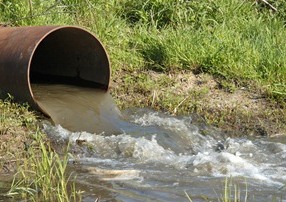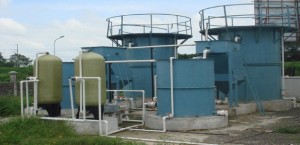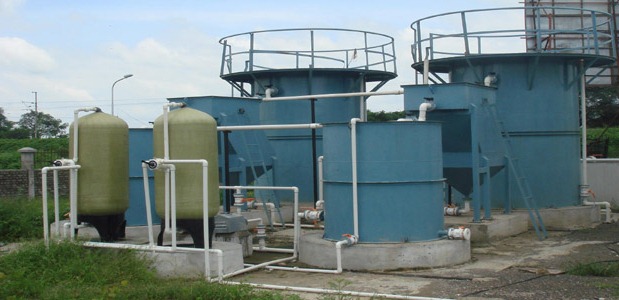The effluent treatment plant is designed to treat the effluent i.e. Wastewater recycling coming from different areas of the plant.
Industrial Waste
Water is one of the most important components used in all types of industry. It is used in many processes of Industry. It may be used for washing, cooling, Heat Exchanging, condensing the steam etc. But Water used in industry is not consumed. Hence, almost all industries generate wastewater from industries that needs serious action. So improper discharge of wastewater can pollute the local environment. In many manufacturing Industries, by-products can be treated as wastewater called “Effluent” should be treated before its release into the environment.

Effluent is an outflow of water or gas from a natural body of water, or from a human made structure and in engineering, is the stream exiting a chemical reactor. It can also be defined as Treated or Untreated Waste water, that flows out of a treatment plant, sewage, or industrial outlet.
So this treatment of waste water i.e. untreated effluent is turned into Treated Effluent with the help of Effluent Treatment Plant (ETP) sometimes it is also called as Sewage treatment Plant (STP). Clean water then is safely discharge into Environment.
Industrial Waste Water
Industrial waste water treatment covers the mechanisms and processes used for waste water treatment that have been contaminated in some way by anthropogenic industrial or commercial activities prior to its release into the environment or its re-use. Its objective is to produce an environmentally safe fluid waste stream (or treated effluent) and a solid waste (or treated sludge) suitable for disposal or reuse (usually as farm fertilizer).
Read here 10 Ways to Reduce Water consumption in Industries
What is the ETP plant?
An Effluent Treatment Plant (ETP) is a specialized facility designed to treat and purify industrial wastewater before its safe discharge into the environment. ETPs employ various physical, chemical, and biological processes to remove contaminants, ensuring compliance with environmental regulations and minimizing negative impacts on ecosystems and public health.
What are the Parameters Standards for ETP?
Effluent from industry must meet the National Standards for waste water set by Government. Effluent Treatment plant ETP or Sewage Treatment Plant (STP) should design & operated in such a way, that it treats the waste water to these standards.
Below are ETP Parameters with standards:
| Parameters | Units | Limits |
| pH | – | 5.5-9.0 |
| Suspended Solids | mg/l | 100 |
| COD | mg/l | 250 |
| Total Dissolved Solids | mg/l | 2100 |
| Total Ammonical Nitrogen | mg/l | 50 |
| BOD 3 Days, 27 0C | mg/l | 100 |
| Oil & Grease | mg/l | 10 |
| Chloride as Cl | mg/l | 600 |
| Sulphate as SO4 | mg/l | 1000 |
| Cyanide | mg/l | 3 |
| Fluoride | mg/l | 2 |
| Lead as pb | mg/l | 0.1 |
| Mercury as Hg | mg/l | 0.01 |
| Nickel as Ni | mg/l | 3 |
| Zinc as Zn | mg/l | 5 |
| Hexavalent Chromium Cr+6 | mg/l | 0.1 |
| Total Metal | mg/l | 10 |
ETP Treated Water Parameters as per CPCB
Effluent Treatment Plant (ETP) treated water must meet the Central Pollution Control Board (CPCB) standards before being discharged into the environment. These standards are designed to limit pollution and protect ecosystems. The parameters include permissible levels for physical, chemical, and biological contaminants such as pH, biochemical oxygen demand (BOD), chemical oxygen demand (COD), total suspended solids (TSS), and heavy metals. Compliance with these parameters ensures that industrial effluents do not harm water bodies or human health.
| Parameter | Permissible Limit (as per CPCB) |
|---|---|
| pH | 5.5 to 9.0 |
| Biochemical Oxygen Demand (BOD) | ≤ 30 mg/L |
| Chemical Oxygen Demand (COD) | ≤ 250 mg/L |
| Total Suspended Solids (TSS) | ≤ 100 mg/L |
| Oil and Grease | ≤ 10 mg/L |
| Total Dissolved Solids (TDS) | ≤ 2100 mg/L |
| Heavy Metals (e.g., Lead, Mercury, etc.) | Varies (e.g., Lead ≤ 0.1 mg/L, Mercury ≤ 0.01 mg/L) |
| Chlorides | ≤ 1000 mg/L |
| Sulphates | ≤ 1000 mg/L |
These parameters are crucial for maintaining environmental sustainability and ensuring industrial accountability.
Effluent Treatment Plant:

Effluent Treatment plant can be operated with the help of 4 diff ways:
1) Preliminary – Removal of Solids, Oil & Grease.
2) Primary – Removal of floating & settable such as Suspended solids, Organic Matter
3) Secondary – Removal of Biodegradable organic matter (BOD).
4) Tertiary – Removal of residual suspended solids, Dissolved solids.
Read More about How to Design ETP Effluent Treatment Plant
Operation & Maintenance of ETP or STP:
The Effluent Treatment plant once constructed/established need to have operation & maintenance through qualified & experience persons to serve efficient & effective operation of ETP, qualified operator & supervisor are being provided by Perfect Pollucon Services who maintains all the records of the operation and attends the day to day trouble shooting.
Learn More About Wastewater Treatment Methods.
Effluent or Sewage Treatment plant Operation and Maintenance Staff Requirements:
The manpower requirement for ETP or STP Operation and Maintenance can broadly be listed as follows:
1) Plant Manager: is an individual with environmental engineering or science /Graduate or Post Graduate Background with experience of at least three years on similar plant(s).
2) Plant Operator(s): is an Individual with at least a High School Pass with sciences and be physically fit and mentally alert. Comprise a team of qualified / trained operators who work in shifts in operating and maintaining screens, grit removal devices, pumps, aerators, valves, etc.
3) Laboratory Analyst: is a qualified individual should be at least B.Sc. with Chemistry who has knowledge of water and waste water chemistry and is trained in preparation of laboratory chemicals, use of laboratory instruments, collection and preservation of water / waste water samples and analysis for various environmental parameters such as pH, SS, BOD, COD, TDS etc.
Above staff is used to run ETP or STP effectively which gives proper result set by respective Govt.
Learn More How Effluent treatment plant is designed?
ETP or STP Operation & Maintenance is Introduction of:
- Various unit operations and processes (Separation by Screening, sedimentation , filtration, Neutralisation, coagulation, Flocculation, Absorption, Adsorption, Chemical Reaction, Oxidation/Reduction, Dissolution, Ion exchange, Chlorination)
- Operation of Units such as Screens (Coarse / Fine Bar screens, Manual/ Mechanically operated), Sumps and Pumping Stations including Pumps, Motors and Panels (Centrifugal Horizontal / Vertical Turbine), Valves(Sluice gates, Non return, Reflux), Pipes/Specials and Pipe Joints, Grit Removal Units. Primary Sedimentation / Settling tanks, Scraping Mechanisms, Sludge withdrawal, Sludge Sumps, Sludge Pumps, Aeration tanks and Aerators, Secondary Settling Tanks, Secondary Sludge Sumps, Pumps, Sludge Thickeners, Sludge Digesters, Gas Production, Sludge handling and Drying.
- Maintenance of Pumps and Motors, Electrical Panels (Starters, Meter, (Energy, Voltage, Amperage, Power factor), Blow out Fuses, Valves, Gates, Scraping Bridge Trolley, Aerators, Reduction Gears, Open Air Weather Casings for Motors, Sprocket wheels and Chains for Mechanical Grit and Screen removing devices.
Frequently Asked Questions:
The operation of the effluent treatment plant is divided into three categories. Primary Treatment involves separating sludge from the liquid using Sedimentation tanks. Secondary treatment involves the removal of biological or organic matter to reduce the bacterial population. Tertiary wastewater treatment often works by using a combination of physical and chemical processes to remove harmful microbiological contaminants from wastewater.
STP Operation involves the separation, removal and disposal of pollutants that exist in the wastewater. The treatment of wastewater is achieved by basic methods or techniques i.e. physical, mechanical, biological and chemical processes to remove impurities from wastewater.
There are three levels of the wastewater treatment procedure, known as primary (Separate sludge from liquid), secondary (Reduce biological population) and tertiary water treatment (to reduce harmful Chemicals).
Effluent Treatment Plants or (ETP) are used by most of the companies in various industries to clean water and remove any toxic and non-toxic materials or chemicals from it so that that water can be reused or released in the environment which will do less harm to the environment.
As Per MPCB, Below is the list of general chemical used in ETP
1. For pH neutralization: Acids (HCl) and base (NaOH)
2. Coagulant / Settling Aids: Aluminium Sulphate, Ferric Aluminium Sulphate, Ferric Sulphate, Ferric Chloride, these may be independent or in combination with Poly Electrolytes (Polymers)
3. For Specific Ion removal, chemicals required as per chemistry of treatment.
4. Nutrients: Urea, Di-ammonium Phosphate
5. Disinfectant: Chlorine, Bleaching Powder (Sodium Hypo-chlorite), Ozone
6. Adsorption / Absorption: Activated Carbon
7. Ion Exchange – based on the specific ion to be removed.
An Effluent Treatment plant is a unit plat where using multiple methods wastewater is treated for its reuse or safe disposal to the environment. This process reduces the demand of fresh water while keeping environment clean.
ETP Plant checklists are list of parameters to be checked at regular intervals to keep everything in check. This inspection technique helps inspection more specific, accurate and efficient. There are many types of checklists can vary based on types of plants and experience of managers.
There are majorly three stages of wastewater treatment i.e., Primary, Secondary and Tertiary treatment. There are also substages in these processes such as bar screening, Aeration, Clarification, Chlorination, Water analysis, water testing and water disposal.
If the effluent in ETP is acidic then caustic soda (Sodium Hydroxide) is added to increase the pH and if the effluent is basic then hydrochloric acid or sulfuric acid is added to Main the pH of the ETP plant.
Why Us as your ETP maintenance vendor?
Our organization is dealing in offering ETP or STP operation & Maintenance Service to medium scale industries. We offer
- Well trained, qualified and experienced operator with expert supervisor to facilitate smooth day to day troubleshooting at operations and maintenance of ETP and STP
- Operators are also trained to maintain all records so that it becomes easier to early signs of irregularity
- Optimum chemical consumption to maximize efficiency
- Achieve outlet norms as per pollution control board
- Preventive maintenance to avoid major breakdown
Our organization has extensive experience in order to Operate & Maintenance of Effluent Water treatment Plant or Sewage Treatment Plant (ETP or STP).


Can an ETP be used to further treat the STP water output)?
Do you take contracts for operations and maintenance of ETP plants in cooperative society?
Yes We do.
Thank you for asking. You can call on numbers mentioned on top-right corner.
we ETP plant for very small scale industry. our industry is ayurvedic drug manufacturing unit at very small scale. water effluent generated 50 lit/day. can you provide service and estimate of overall ETP plant
Sure you can call us on 9930180059 for More information.
We need a ETP PLANT FOR primary treatment of waste water for garment dyeing industry
Request you to call on Above mentioned number so that our representative can help you on your query.
Sir am prahlada k we r installed new ETP (Electro coagulation method) but we can not controlled the TDS, initially tds-15000 is present in the wast water,after treatment we will get same TDS any solutions you have please suggestion me ….
Thank u sir
Prahlada k
Great Information on Operation & Maintenance of ETP and STP Plants. Thanks for the Informative content.
WHAT IS DESIGN CRITERIA OF ETP.
Hi Aditya,
The design criteria of an Effluent Treatment Plant (ETP) are guidelines and specifications that define the necessary parameters for the effective design and operation of the plant. These criteria typically include factors such as the nature and characteristics of the wastewater, the required effluent quality standards, and the treatment processes and technologies to be employed. The design criteria ensure that the ETP is capable of treating the wastewater to meet regulatory requirements and environmental standards.
Team PPS
Can you plz tell me how much chemical etp cost for purify 1000 liter water?
Hi,
The cost of operating a chemical Effluent Treatment Plant (ETP) to purify 1000 liters of wastewater in India can vary widely depending on several factors, including the type of pollutants, the complexity of the treatment process, the chemicals used, and the scale of the operation. However, a rough estimate for chemical treatment costs typically ranges between ₹5 to ₹20 per 1000 liters of wastewater.
This cost includes the price of chemicals like coagulants, flocculants, pH adjusters, and other consumables, but it can be higher if the wastewater contains hazardous or complex pollutants that require additional treatment steps.
Thanks
TeamPPS
This article offers a clear and engaging explanation of how sewage treatment plants function. It highlights the essential process of converting wastewater into safe, reusable water through various stages: preliminary, primary, secondary, and tertiary treatments. The breakdown of each stage, from removing large debris to advanced polishing techniques like microfiltration and UV disinfection, provides a comprehensive view of how sewage treatment protects both public health and the environment. Overall, it effectively illustrates the critical role sewage treatment plants play in maintaining water quality and ecosystem health.